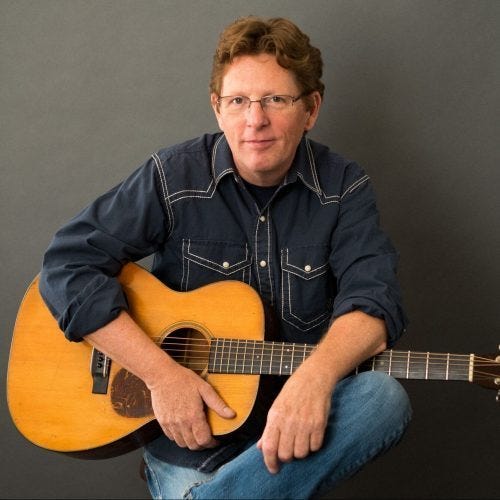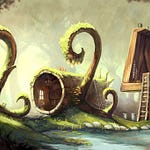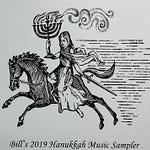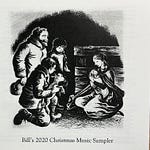
Today’s songs are both by the Nashville “first call” session musician and singer-songwriter Tim O’Brien. (“First call” is recording industry jargon for being first choice when the back-up musicians are being chosen. Such musicians are often not famous with the general public but are highly-admired within the profession.)
He was born and raised in Wheeling, West Virginia and began performing with his sister Mollie O’Brien while they were still in high school. Both Tim and Mollie are still going strong in their solo music careers. Tim’s began in 1978 and since then he and his bands have received two Grammy awards (for Best Traditional Folk Album in 2005 and Best Bluegrass Album in 2014) as well as many other accolades.
If you want to know more about Tim, besides from his above-linked website and his Wikipedia entry, you could read his recently-published biography Traveler: The Musical Odyssey of Tim O’Brien written by country music historians Bobbie and Bill C. Malone (Professor Emeritus of History at Tulane University.)
I got Makin’ Plans from a 1991 sampler album called Sugar Plums, released by the country & western Sugar Hill Records label. You can also see him singing it with his wife Jan Fabricious in a 2010 concert, or better yet in their home in a 2020 Covid-year video. I don’t know when the song was written or first recorded, or more accurately, I don’t want to spend more time trying to track it down. I do know that it isn’t on his Odd Man In album that Sugar Hill released that year. My guess is that it was recorded specifically for the Christmas sampler.
Tim and Thomm Jutz wrote Old Christmas Day in 2022. Apparently it was released by Tim as a single about that time but it is also now included as a bonus track with downloads of his 2017 album Where the River Meets the Road.
The song is in the context of an old Christmas belief that was once widespread throughout Europe that at midnight on Christmas Day farm animals can speak. Because it is so widespread and with many variations, some folklorists speculate that it is a Christianized version of an ancient pagan belief related to the winter solstice. In this song, that power is associated with “Old Christmas” (January 6) which is still celebrated as the “real” Christmas by the Orthodox Church and by some rural people in western countries.
Here is the explanation for the context of the song, and its lyrics, from Tim O’Brien’s website:
The new and more scientifically accurate Gregorian calendar was introduced by Pope Gregory in 1582. Eleven days shorter than the previous Julian calendar, it still labeled December 25th as Christmas, but the day that had been December 25th was now labeled January 6th. (Of course, for the past 2 years, January 6th means something else. I even have a song about that but let’s not go into that here.)
Britain and its colonies adopted the new calendar officially in 1752, but Protestants in America and elsewhere generally rejected anything to do with the Catholic church. Appalachia was especially slow to adopt the new system but started calling January 6th “Old Christmas”.
In remote mountain communities, a lot of Christmas folklore remained attached to January 6th. There were various beliefs – don’t throw out the ashes from the Old Christmas day fire until the next day; water turns into wine that day but it’s bad luck to taste it (drink beer or whiskey instead?); and a child born on Old Christmas day can heal the sick.
It’s also good luck to eat a piece of pie or cake made by another person on Old Christmas day. So, bake stuff and try to get others to eat it and hope they offer you something that came from their oven. (The tradition of eating mince pies and fruit cakes made with whiskey came to America with the Scots Irish.) The calendar change also gave birth to the idea of “the twelve days of Christmas”, and in Appalachia, a tradition called “breakin’ up Christmas” emerged with people visiting family and friends for several days at a time.
One belief was that at midnight on Old Christmas Eve, the elder bushes bloom and animals talk to each other. The legend had to do with those animals’ presence at Jesus’s birth, and their being filled with the Holy Spirit once a year on that night. Thomm Jutz and I got together to write a song on January 5th, and this is the result. Thanks to Thomm for uncovering this bit of folklore. They say it’s bad luck to hear the animals talk on Old Christmas Eve, but we can still imagine what they might say!
Jan and I here at Howdy Skies Records world headquarters wish you a warm and peaceful Christmas and a prosperous New Year. One last thing, it’s good luck to keep your tree up until January 6th, but bad luck to leave it up past that date.
Old Christmas Day
©2022 Tim O’Brien and Thomm Jutz / No Bad Ham Music / ASCAP /
Thomm Songs / SEASACIn the middle of the night on old Christmas Eve
The elder bushes bloom while the people are asleep
The animals start talking and they have a lot to say
In the middle of the winter night on old Christmas day
Christmas Day, Christmas day
In the middle of the winter night on old Christmas dayThe bears all take a break from their long winter nap
The birds talk to each other and the dog talks to the cat
If you couldn’t say a word all year, I wonder what you’d say
In the middle of the winter night on old Christmas day
Christmas Day, Christmas day
In the middle of the winter night on old Christmas dayThe buzzards all are gathered out behind the bar
Telling buzzard stories, spinning buzzard yarn
They talk about the feast that they had yesterday
Roadkill for dinner on old Christmas day
Christmas Day, Christmas day
In the middle of the winter night on old Christmas dayThe sheep and all the chickens, the cattle and the pigs
The rooster’s on the fence, the crickets play a jig
They’re airing every grievance, get their woes out of the way
Wrapping up another year on Old Christmas day
Christmas Day, Christmas day
In the middle of the winter night on old Christmas day













Share this post